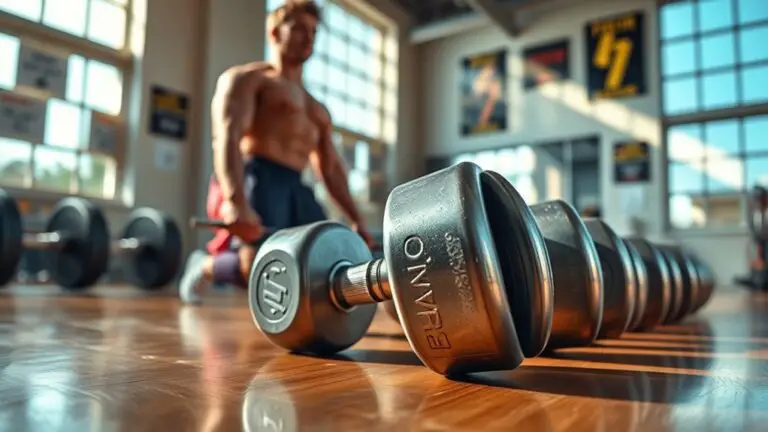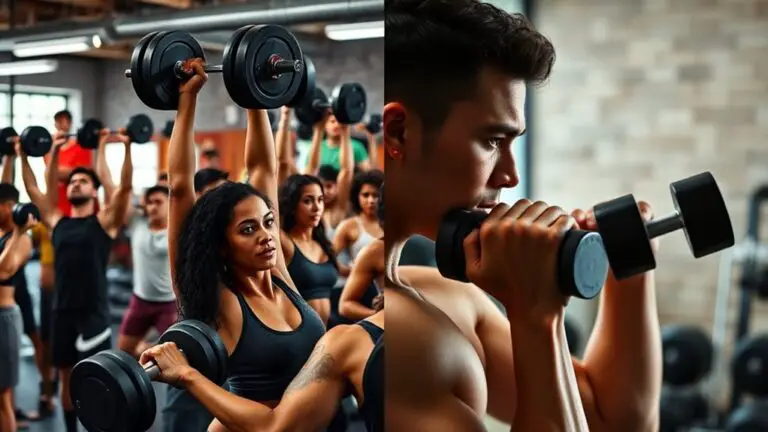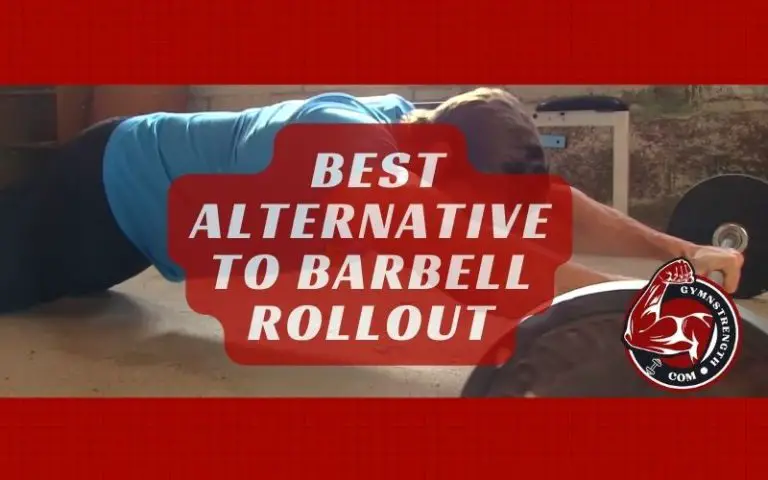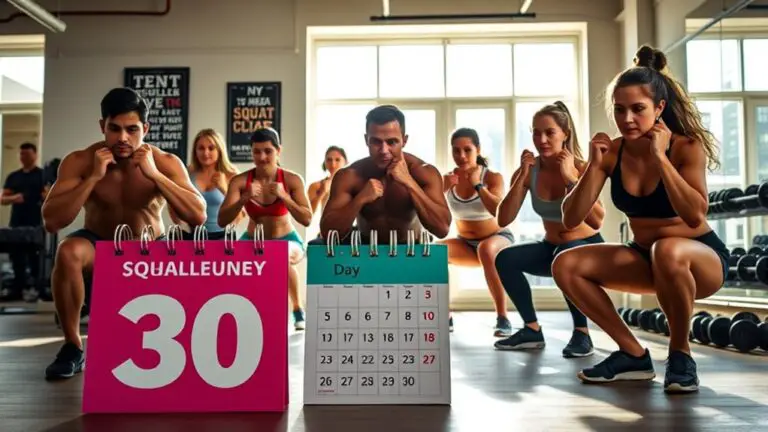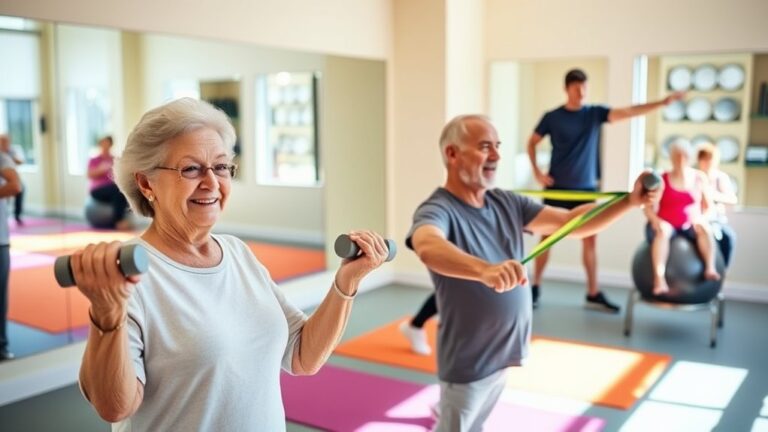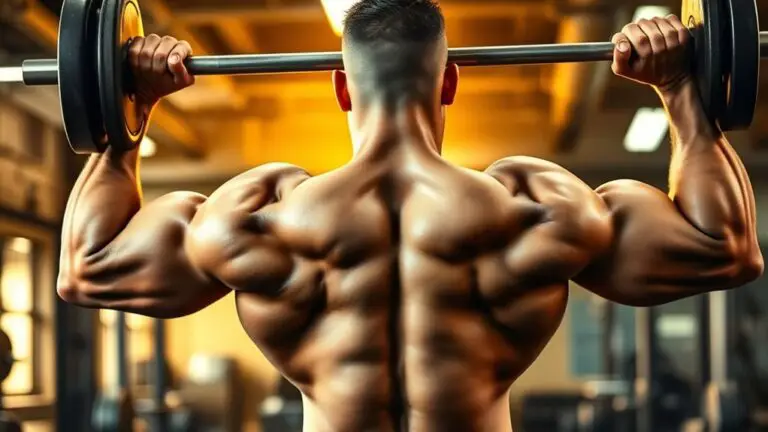How to Use a Leg Press Machine Correctly
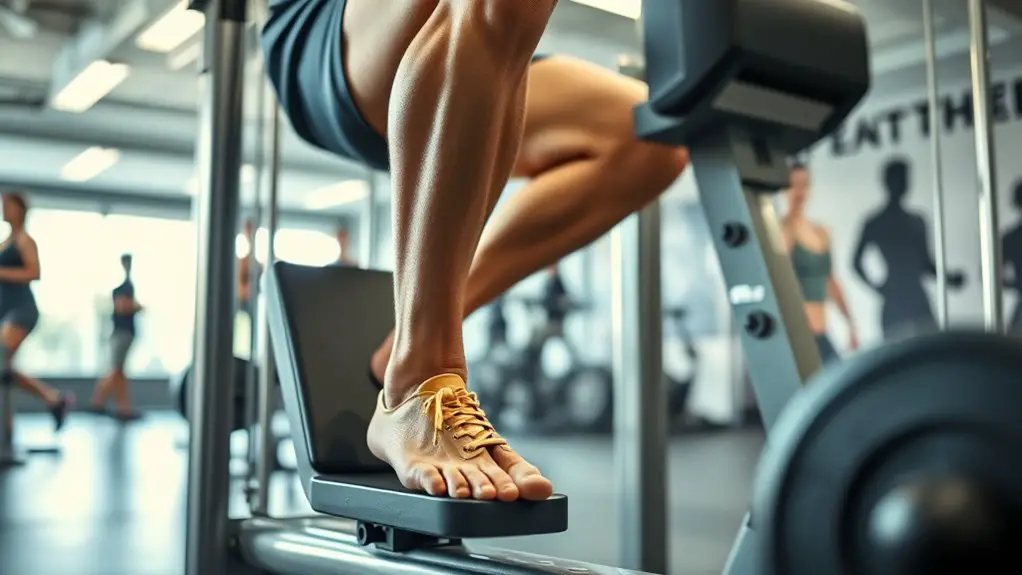
To use a leg press machine correctly, start by adjusting the seat so your knees align with the pivot point. Sit back against the padded seat with feet shoulder-width apart on the platform. Select a manageable weight and engage your core. When pressing, keep your knees in line with your toes and avoid locking them at the top. Focus on maintaining proper form and gradually increase weight as you progress. There’s more to learn about optimizing your workout effectively.
Understanding the Leg Press Machine
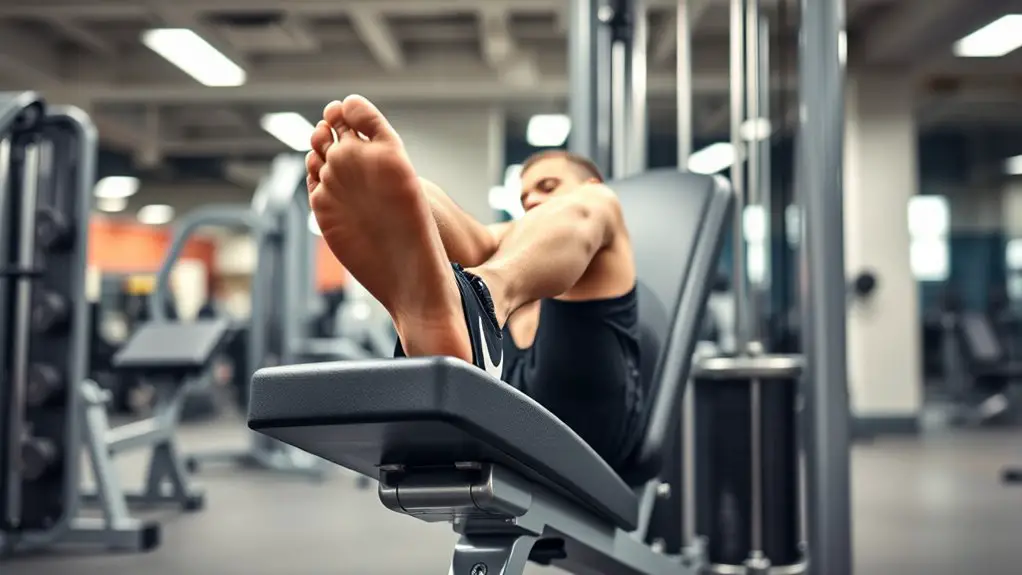
The leg press machine is a powerful tool for building lower body strength. It targets key muscle groups like your quadriceps, hamstrings, and glutes, offering significant leg press benefits. By using this machine, you can effectively enhance your overall leg strength while minimizing strain on your back, especially if you maintain proper form.
There are several machine types available, including the horizontal leg press and the angled leg press. Each type has its own unique features, allowing you to choose what feels most comfortable for you. You should consider factors like your fitness level and any existing injuries when selecting a machine.
Focusing on safety is vital; always make sure your feet are positioned correctly and avoid locking your knees during the exercise. With the right approach, the leg press can be a safe and effective part of your workout routine, helping you achieve your strength goals.
Setting Up the Machine
Before you start using the leg press machine, you’ll need to adjust the seat position to guarantee proper alignment. Once you’re comfortable, select an appropriate weight that matches your fitness level. This setup is essential for maximizing your workout and preventing injury.
Adjust Seat Position
Start by adjusting the seat position to guarantee a comfortable and effective workout. Proper seat adjustments are essential for safety and performance. Sit down and place your back against the backrest, ensuring your knees are aligned with the machine’s pivot point. Adjust the seat until your feet can comfortably reach the platform while maintaining a slight bend in your knees. This helps to prevent strain during your exercise. Make sure the machine settings are secure before you start. Double-check that the seat is locked in place, as any movement could lead to injury. Remember, a well-adjusted seat not only enhances your workout but also minimizes risks, allowing you to focus on your form and technique.
Select Appropriate Weight
Selecting the right weight is vital for maximizing your workout on the leg press machine. Start by using weight selection techniques, which help guarantee you’re lifting a safe and effective load. It’s essential to begin with a lighter weight if you’re unsure about your strength level; this allows you to test your comfort and form without risking injury. Gradually increase the load, focusing on adjusting resistance levels to match your fitness goals. You should be able to perform 8-12 repetitions with good form, feeling challenged but not strained. Always listen to your body—if you feel any pain or discomfort, reduce the weight. Prioritizing safety will lead to better results and a more enjoyable experience on the leg press machine.
Positioning Your Body
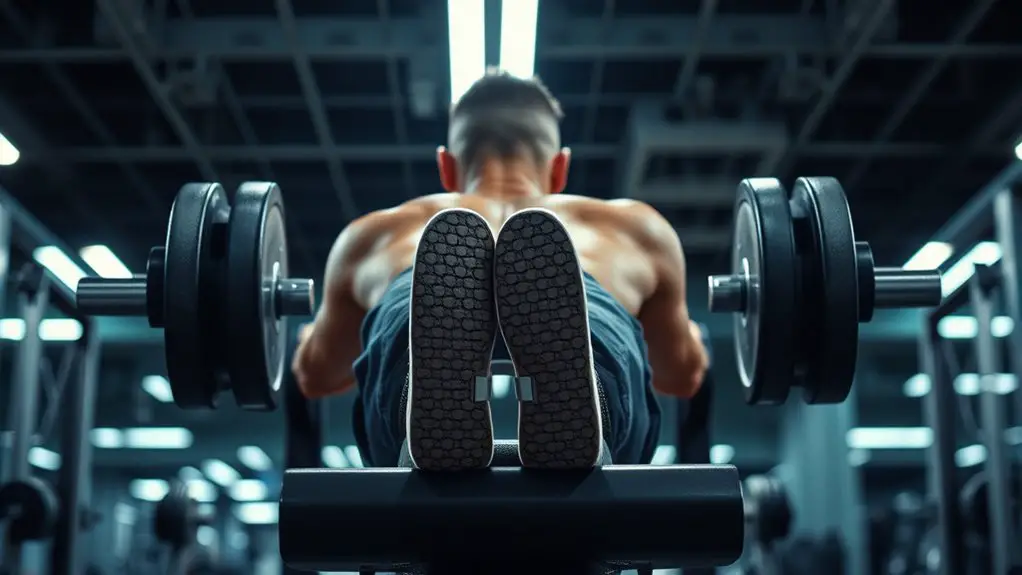
Getting your body positioned correctly on the leg press machine is essential for both safety and effectiveness. Start by sitting back against the padded seat, confirming your back is fully supported. Your feet should be placed shoulder-width apart on the platform, with your heels flat and toes slightly pointed out. This setup promotes proper body alignment and helps prevent injury.
Before you begin, engage your core by tightening your abdominal muscles. This stability will protect your lower back during the exercise. Make sure your knees track in line with your toes as you lower the platform, avoiding any inward or outward movement.
Finally, adjust the seat if necessary, so your knees form a 90-degree angle at the start of your movement. With these adjustments, you’ll guarantee a safe and effective workout, maximizing the benefits of the leg press machine.
Choosing the Right Weight
When it comes to choosing the right weight for the leg press machine, it’s vital to find a balance that challenges you without compromising your form. Start by considering your personal fitness goals. Are you aiming for strength, endurance, or muscle growth? Here are some effective weight selection strategies:
- Begin with a warm-up: Start with a lighter weight to get your muscles ready.
- Focus on reps: Aim for 8-12 reps that feel challenging but allow you to maintain proper form.
- Progress gradually: Increase the weight incrementally to avoid injury and guarantee continuous improvement.
Always listen to your body; if you feel strain or discomfort, it’s a sign to lighten the load. Remember, safety is key. Choosing the right weight not only enhances your workout but also prevents injuries, allowing you to reach your fitness goals effectively.
Proper Foot Placement
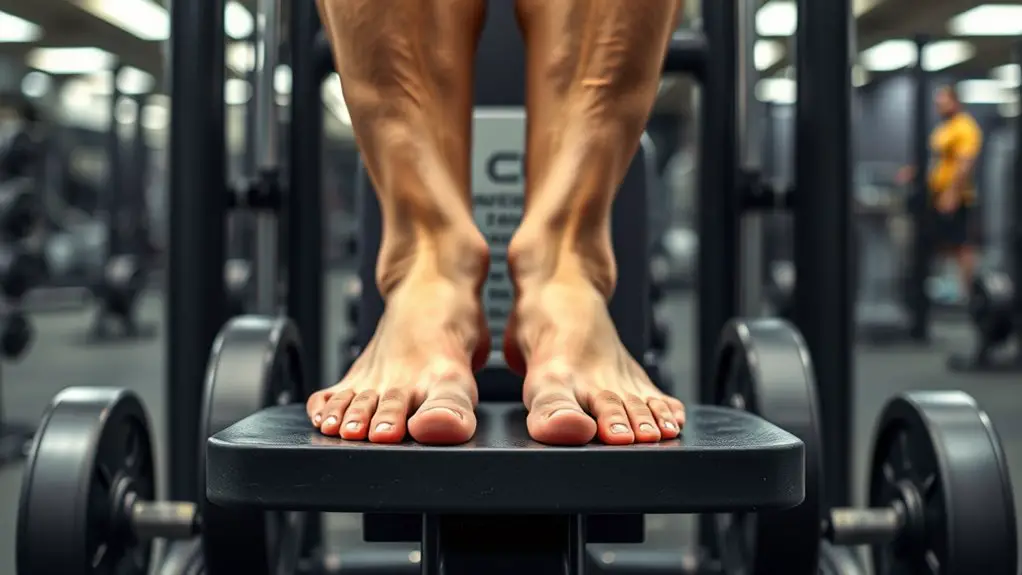
When using the leg press machine, proper foot placement is essential for maximizing your workout and preventing injury. Pay attention to your stance width and how your heels and toes are aligned to guarantee you’re targeting the right muscles effectively. Getting this right can make all the difference in your leg press experience.
Foot Positioning Importance
Foot positioning on the leg press machine is essential for maximizing your workout efficiency and safety. Proper foot placement not only enhances your grip strength on the platform but also guarantees that your knees and back stay protected throughout the exercise.
Here are some key points to reflect on:
- Foot angle: Keep your feet flat and aligned to avoid unnecessary strain on your joints.
- Foot placement: Position your feet shoulder-width apart to maintain balance and stability.
- Weight distribution: Evenly distribute your weight across your feet to engage the right muscles without compromising your form.
Stance Width Considerations
Choosing the right stance width on the leg press machine can greatly impact your workout effectiveness. A narrow stance targets your quadriceps more, helping to build strength in the front of your thighs. However, it can also put additional stress on your knees, so be cautious if you have existing knee issues. On the other hand, a wide stance engages your inner thighs and glutes, distributing the weight more evenly. This can be a safer option for those looking to minimize knee strain. Regardless of your choice, guarantee your feet are firmly placed on the platform, and focus on controlled movements. Always listen to your body, and adjust your stance if you experience discomfort during your workout.
Heel and Toe Alignment
Getting your heel and toe alignment right is essential for maximizing your leg press workout. Proper heel placement and toe alignment not only enhance your performance but also help prevent injuries. Here’s how to guarantee you’re set up correctly:
- Feet shoulder-width apart: Keep your feet evenly spaced to maintain balance.
- Heel placement: Position your heels on the footplate, guaranteeing they’re flat and secure.
- Toe alignment: Your toes should point slightly outward, allowing for a natural range of motion.
Executing the Leg Press Movement
To execute the leg press movement effectively, position yourself comfortably in the machine with your back firmly against the padded support. Adjust the seat so your knees are bent at about a 90-degree angle when your feet are on the platform. Make certain your feet are flat, shoulder-width apart, and aligned with your knees.
As you begin, push through your heels to extend your legs, focusing on engaging your quadriceps, hamstrings, and glutes. This action maximizes muscle activation, allowing you to experience the leg press benefits fully. Remember to avoid locking your knees at the top of the movement to keep tension on the muscles and reduce the risk of injury.
Control the descent as you bend your knees, returning to the starting position slowly. This controlled movement not only helps maintain safety but also enhances muscle growth and strength over time.
Common Mistakes to Avoid
While using the leg press machine can be highly effective, there are several common mistakes that can hinder your progress and increase the risk of injury. It’s essential to be aware of these common errors to guarantee you’re getting the most out of your workout safely.
- Not adjusting the seat properly: If the seat’s not set right, you’ll end up with improper form, leading to strain on your back or knees.
- Locking your knees: Fully extending and locking your knees at the top of the movement can place unnecessary stress on your joints.
- Using too much weight: Trying to lift more than you can handle compromises your form and increases the likelihood of injury.
Incorporating Variations for Progression
Incorporating variations into your leg press routine can help you break through plateaus and keep your workouts fresh. By implementing exercise variations, you can target different muscle groups and enhance overall strength. For instance, adjusting the foot placement on the platform can shift focus between your quads and hamstrings.
To achieve progressive overload, consider gradually increasing the weight you lift or adding more reps over time. You might also try single-leg presses to improve balance and stability. Another option is to incorporate different tempos, like slowing down the eccentric phase, which can intensify the workout.
Tips for Safety and Injury Prevention
As you explore variations in your leg press routine, it’s important to prioritize safety and injury prevention. Implementing proper safety measures can help you avoid unnecessary harm and guarantee an effective workout. Here are some key tips to keep in mind:
- Adjust the seat correctly: Make sure your knees are aligned with your feet to prevent strain.
- Use a controlled motion: Avoid jerky movements; focus on a smooth and steady press.
- Don’t overload the machine: Start with lighter weights to master your form before increasing resistance.
Frequently Asked Questions
Can Beginners Use the Leg Press Machine Safely?
Using the leg press machine as a beginner can be as safe as wearing a seatbelt in a car, if you follow proper form. Always start with a lighter weight to get comfortable with the movement. Make certain your back stays flat against the pad, and your feet are positioned shoulder-width apart. This guarantees beginner safety and helps prevent injuries. Remember, it’s better to take your time and learn correctly than to rush.
How Often Should I Use the Leg Press Machine?
You should aim to use the leg press machine about 1 to 3 times a week, depending on your workout routines and fitness goals. Following these frequency guidelines helps guarantee you don’t overtrain and allows your muscles to recover. If you’re a beginner, it’s essential to listen to your body and avoid pushing too hard too soon. Always prioritize safety by maintaining proper form and gradually increasing weight as you gain strength.
What Muscle Groups Does the Leg Press Target?
The leg press primarily targets your quadriceps, giving them a solid workout through activation as you push the platform away. You’ll also engage your hamstrings, which helps balance muscle development and enhances overall leg strength. For safety, make sure your feet are positioned correctly, and don’t overload the machine. Proper form not only maximizes your workout but also minimizes the risk of injury, keeping your fitness journey on track.
Are There Alternative Exercises to the Leg Press?
Absolutely, there are several effective alternatives to the leg press. You might consider squat variations, like front squats or goblet squats, which can strengthen your legs and core while promoting proper form. Lunges alternatives, such as step-ups or Bulgarian split squats, can also target similar muscle groups. Remember, it’s crucial to maintain good form to avoid injury, so start with lighter weights or bodyweight exercises to guarantee you’re comfortable and safe.
Can Leg Press Improve Athletic Performance?
Studies show that athletes can increase leg power by up to 15% through targeted resistance training. If you’re focused on improving athletic performance, incorporating leg presses into your routine can enhance sports conditioning by building strength in your lower body. Just make sure you’re using proper form to prevent injury. A strong foundation not only boosts your power but also supports overall athletic efficiency, which is essential in competitive sports.
